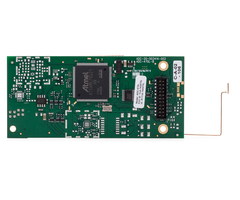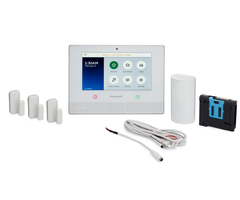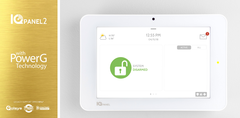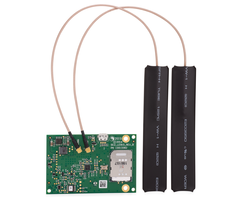If you're looking for reliable alarm monitoring service in Canada, then Alarm Grid is here for you! We happily monitor many Canadian homes and businesses and provide people with the peace of mind that they deserve. Our company offers central station monitoring services throughout Canada.

Many Canadians wonder if we can provide central station monitoring services for their homes and businesses. The answer to that question is yes. Not only can we connect Canadian security systems with a 24/7 central monitoring station, we can also ensure that emergency services will be sent out during break-ins, fires, carbon monoxide gas outbreaks and medical crises. We are proud to offer these important services to homes and businesses throughout Canada.
What is Central Station Monitoring?
First, it's important to understand what exactly is central station alarm monitoring. When a security system goes into alarm, the control panel sends out a distress signal using its communicator. This signal is routed to a central monitoring station that operates 24 hours per day, 7 days per week, 365 days per year (366 on leap years).
The incoming signal will be immediately received by a highly trained operator, who will take action based on the type of signal and the user's account settings. The typical protocol is to contact the end user and make sure everything is okay. If the operator is unable to reach the end user, or if the end user gives indication that they need help, the operator will then request emergency dispatch to the area. Thanks to alarm monitoring, many criminals have been successfully apprehended, and countless lives have been saved.
In order for central station monitoring to work, the security system must be able to send out various types of signals during alarm and other events. These signals must travel across an established communication network and reach the central station. Most systems send out signals across a cellular network and/or an IP network. Alarm Grid recommends using cellular communication whenever possible, as it offers superior reliability. However, IP-only communication can still serve as a viable option.
Alarm Grid central station customers in Canada receive monitoring service from Rapid Response Monitoring Services (RRMS). The company operates two (2) central stations, located in the United States (Southern California and New York State). When an alarm comes through from a Canadian security system, RRMS will have no problem contacting the end user in Canada and ensuring that emergency dispatch is sent out, when necessary.

Alarm Monitoring in Canada
Central station monitoring requires that an alarm system is capable of sending out emergency signals whenever alarm events occur. These signals must be able to successfully reach a central monitoring station. This is the only way for an end user to receive automatic emergency dispatch when they need it most.
An important consideration must be made when alarm monitoring service is conducted internationally. The security system will need to communicate across a network that is carefully designed for devices in the country where the system resides. For IP communication, this is no problem. Internet Protocol (IP) is relatively universal, and an IP device from one country should have no problem connecting with the local networks in different country. But things become a little more tricky when cellular communication is considered.
Cellular communication networks are established by service providers specific to that country of installation. Each service provider wants to ensure that only their customers are able to communicate across their networks. That is why they outfit their phones and other cellular devices with communicators that are designed to work with their unique networks. This is very important for these service providers to maintain and grow a successful business.
The cellular networks in Canada are different from those in the United States. If you bring a Canadian mobile device into the United States, it will usually need to roam to a cellular network unique to the area in which it is being used. If the device is unable to roam to a different network, then cellular communication will be impossible. The same is true if you use an American alarm monitoring communicator in Canada. The American communicator will need to roam to a Canadian cellular network.
But roaming to an international network isn't always easy. You cannot always expect a device from one country to work across a random cellular network in a different country. This is only possible if two cellular service providers from different countries have established a deal to allow their respective devices to roam to the other company's cellular networks.
Even then, this isn't always that simple. Most cellular service providers will charge roaming fees when a customer uses a device on an international network. For cellular alarm monitoring service, these fees are incurred by the company that operates the necessary communication servers. These are companies like Resideo's AlarmNet and Alarm.com. Those fees are then passed on to the alarm monitoring company.
Cellular roaming can result in high fees. As a result, many companies that operate alarm monitoring communication servers will shut down service for any security system that uses cellular roaming to connect with their servers. Only certain companies will allow alarm communicators to use roaming to connect with their networks. Fortunately, cellular communicators for alarm systems don't usually change locations once they've been installed. But, it's important to purchase a cellular communicator that is meant to work in the area of installation.
Most of the alarm monitoring communicators sold on the Alarm Grid website are designed for use in the United States. Only a small number will roam to a Canadian cellular network. And even then, some companies that operate alarm monitoring communication servers will not allow this. If you want cellular monitoring service in Canada, you will need a Canadian communicator or an American communicator that can roam to a Canadian cellular network. If you go with the latter, you must make sure the server operator won't shut down the service.
Fortunately, Alarm Grid does offer a few reliable options for Canadian users.

Qolsys IQ Panel 2 Plus AT&T LTE
Perhaps the best option for Canadian customers is the Qolsys IQ Panel 2 Plus AT&T LTE version. This is an excellent security system for both residential and commercial use. The panel features a beautiful 7-inch full-color touchscreen display, and its sleek, modern design allows it to fit-in nicely with almost any decor. The system supports 128 wireless zones and great features like automatic Bluetooth Disarming, live streaming from compatible Alarm.com Cameras, partitioning, facial recognition and built-in Z-Wave Plus control. These features help to make the IQ2+ one of the most complete and robust systems available.
But the reason why the Qolsys IQ Panel 2 Plus AT&T LTE is perfect for Canadian users is that the built-in AT&T LTE Communicator will roam to the Rogers LTE Network in Canada. Anyone living in an area covered by the Rogers LTE Network can expect the IQ Panel 2 Plus AT&T LTE to work reliably. Alarm.com won't shut down the connection, and Qolsys has informed us that there should be no issues. Please note that you will need a Gold Plan or higher (Self or Full) to use the AT&T LTE Communicator and connect with the Alarm.com Servers.
Additionally, the system also includes an integrated WIFI card. This means that a dual-path setup will be possible right out of the box. In fact, this is currently the only dual-path option that Canadian customers can purchase from our website. Each IQ Panel 2 Plus System can support PowerG Sensors that utilize 128-bit AES encryption and can communicate with the system from up to 2,000 feet away in open air. You will also have the choice of one legacy sensor frequency. These frequency options are 319.5 MHz, 345 MHz and 433 MHz. These frequencies are for Interlogix and Qolsys, Honeywell/Resideo and 2GIG, and DSC legacy RF sensors respectively.
The following IQ Panel 2 Plus Systems will work across the Rogers LTE Network in Canada:
Please note that the Verizon LTE Version will not work in Canada. This is because the communicator will not roam to a Canadian cellular network. Additionally, Qolsys also offers a Telus LTE version of the IQ Panel 2 Plus. At this time, we do not offer the Telus LTE variant on our website. However, if you are able to purchase an IQ Panel 2 Plus Telus LTE System, we will be happy to activate it and provide reliable cellular monitoring service.

Interlogix Telus LTE Communicator
The Interlogix 600-1048-XT-LTE-TL and the Alarm.com XT-511-CA-TL are both Telus LTE Communicators for the Interlogix Simon Series Systems. With the impending sunset of 3G networks, we strongly recommend purchasing an LTE communicator for your alarm system. This makes the Interlogix Telus LTE Communicators a great choice for Canadian users. If you don't need the advanced features of the IQ Panel 2 Plus, then you can certainly do well with an Interlogix Simon System and a Telus LTE Communicator.
Interlogix Systems have long been regarded as excellent budget and economical security systems. They are relatively basic in terms of functionality, and they will provide reliable and trustworthy monitoring service for the end user. The Simon lineup includes the Interlogix Simon XT, the Interlogix Simon XTi, the Interlogix Simon XTi-5, and the Interlogix Simon XTi-5i. All four systems can support the Interlogix 600-1048-XT-LTE-TL and the Alarm.com XT-511-CA-TL. But please note that the Simon XT must be running at least firmware version 1.3 to use a cellular communicator. All versions of the XTi, XTi-5, and XTi-5i can support the module. Remember though, you will need a Gold Plan or higher (Self or Full) from Alarm Grid to support the module. For more information on upgrading a Simon Panel to LTE, please see this helpful FAQ.
Most Interlogix Simon Panels support up to 40 zones, and the cellular communicator add-on also functions as a Z-Wave controller for smart home automation capabilities. The communicator will let the system connect with the Alarm.com service. This will allow you to control your system remotely using the Alarm.com Mobile App. You can also access the app to view Alarm.com Cameras and control Z-Wave devices. While there are certainly more robust systems available, an Interlogix Simon System is still more than serviceable for many homes and smaller businesses.
Please note that the Interlogix Telus LTE Communicator is a special order item for us. It may take longer than average to arrive in the mail. Keep this in mind when ordering this product.

IP Only Monitoring
Although cellular monitoring is recommended due to its exceptional reliability, you can still go with an IP only monitoring setup. In fact, many users prefer this because of the lower monitoring costs. If you have reliable internet service, then this can work quite well. Just remember that if your internet does go down, then your home or business will be vulnerable. Alarm Grid is not responsible for internet outages, so do this at your own risk.
The thing with IP only monitoring is that you will not be able to use Alarm.com. This is because accessing Alarm.com requires a compatible cellular communicator. For that reason, you will want to use an AlarmNet System instead. And the only systems that can access AlarmNet360 and Total Connect 2.0 are those from Resideo (formerly Honeywell). But despite those restrictions, you are free to choose from virtually any Resideo Security System from our website.
Alarm Grid recommends the Resideo Lyric Alarm System for any Canadian user looking to go the IP only route. This system comes with a 2.4 GHz WIFI communicator built-in, so you won't need any additional equipment to connect it to your local IP network. It can support 128 wireless zones, 72 Z-Wave devices and nearly all of the devices from the Honeywell 5800 Series. It can also support its own lineup of Honeywell SiX Series Sensors that offer 128-bit AES encryption and a 300-foot nominal wireless communication range.
By going with IP only monitoring service, you can save money with a Bronze or Silver Plan instead of purchasing a Gold Plan. However, you will still need to upgrade to Platinum if you want video surveillance service. All of our plans other than standard Bronze include access to Total Connect 2.0 so that you can control your system remotely. The Total Connect 2.0 Mobile App can be downloaded for free from the Google Play Store and the Apple App Store. This is an outstanding platform for Arming and Disarming, checking current system status and controlling your Z-Wave smart home devices from anywhere.

Sign-Up for Alarm Monitoring in Canada!
Alarm Grid welcomes anyone in Canada who wants dependable and trustworthy monitoring service. We already provide exceptional service and support for hundreds of Canadian customers. We would love for your home or your business to join our growing family. To get started, please visit out alarm monitoring page to learn more about the monitoring plans we offer.
And if you have any questions or concerns about alarm monitoring, we would certainly like the opportunity to speak with you. The best way to reach us is to email support@alarmgrid.com. We will check your email at our earliest convenience and respond back as quickly as possible. If you would prefer to speak on the phone, we can be reached at (888) 818-7728. Our regular office hours are 9am to 8pm EST M-F. We look forward to hearing from you and monitoring your home or business for many years to come!







 In order to use this communicator, your 2GIG GC3 or 2GIG GC3e System must be running Firmware Version 3.2.3 or higher. This update can be pushed down to your panel from Alarm.com by your monitoring company for a small fee. Alarm Grid customers can contact us to do this. You can also apply the update locally at the panel using a USB drive. Updating locally is completely free. More information on how to apply the update locally can be found
In order to use this communicator, your 2GIG GC3 or 2GIG GC3e System must be running Firmware Version 3.2.3 or higher. This update can be pushed down to your panel from Alarm.com by your monitoring company for a small fee. Alarm Grid customers can contact us to do this. You can also apply the update locally at the panel using a USB drive. Updating locally is completely free. More information on how to apply the update locally can be found 










